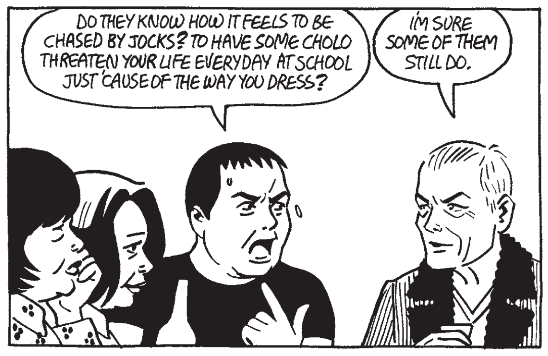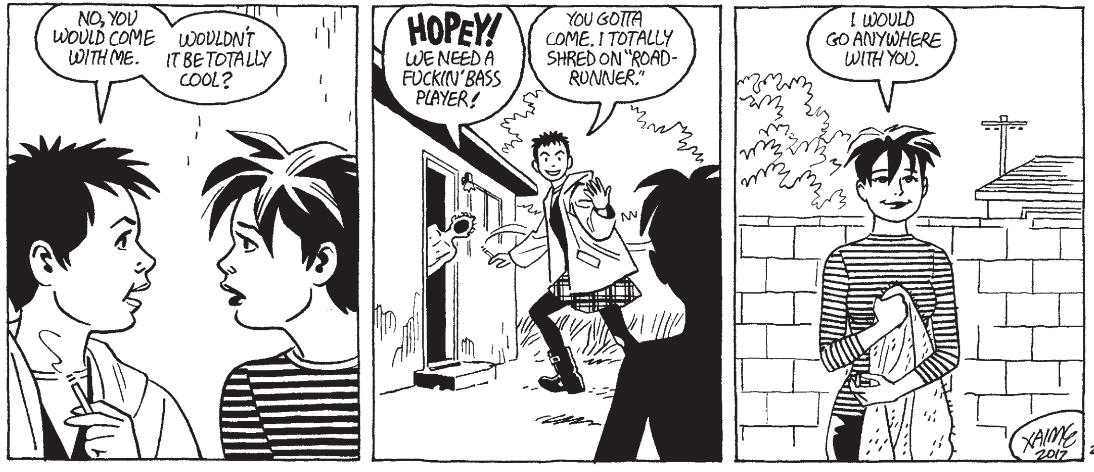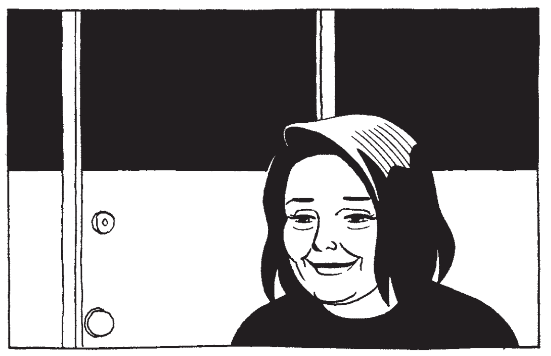Can you ever really go home again?
This is the central question of Jaime Hernandez's Is This How You See Me? Collecting serialized comics from the past five years into a cohesive graphic novel, Is This How You See Me? is a moving tale of friendship, aging, and how the past shapes how we see the present.
Is This How You See Me? takes place over a single weekend in the mid-2010s. Best friends Maggie and Hopey return to their childhood hometown Huerta (or "Hoppers," in Love & Rockets slang) for a punk rock reunion party and concert. Ray, Maggie's boyfriend, and Sadaf, Hopey's wife, stay behind in Los Angeles. While both are gracious about being left out, it's clear that they are anxious about their significant others spending the weekend together alone. Maggie and Hopey were on-again, off-again lovers for years after all, and the pair tends to wildness.

Maggie and Hopey are hardly the punk rock heroes they once were, though. They're domesticated, concerned with their present lives with their present partners more than they are with the idealism and energy of their youth. And while their bond is intense, rooted in a rich past, they are also slightly anxious around each other, unsure exactly of how far the the parameters of their long friendship now extend. This anxiety is neatly summed up in two panels where Maggie and Hopey, who have been checking in on their significant others, vow to stop and reconnect with each other instead:

In addition to their anxieties about each other, Maggie and Hopey are both nervous about their Hoppers reunion. And with good reason. Is This How You See Me? portrays just how incestuous, backbiting, cliquish, and claustrophobic a niche music scene can be. Maggie and Hopey---particularly volatile Hopey---are rightfully apprehensive about going back to the scene that they called home.

Even if the Huerta punk rock scene was full of infighting, it was still a liberating place for outsiders like Maggie and Hopey. Jaime Hernandez deftly evokes how it feels to have been someone on the fringe, someone threatened for being different or weird. The evocation is all the more potent in its maturity: In Is This How You See Me? the weirdos and punkers grow up to realize that everyone is weird in some way. But of course, if everyone is weird, where does that leave the true weirdos?
Hernandez's novel gives voice to the true believer's complaint that punk rock has been co-opted by the mainstream, punk's weirdness commercialized, compartmentalized, and made acceptable. Throughout the novel, characters lament about the posers, or "weekenders" in the Hoppers parlance (an ironic term considering that the all the former scenesters who are back in town for the reunion have literally come in for just the weekend). For the true believers, punk rock was a home, not a tourist attraction for the poser weekenders. Ironically winking, Hernandez, shows that these one-time idealists are themselves reactionary oldsters yelling at a younger generation to get off their (punk rock) lawn.

For Maggie, the central character of Is This How You See Me?, the punk rock reunion is initially deeply dissatisfying. Her nostalgic idealism meets strange reality: her punk rock scene was just one small clique flitting about in a bigger, flowing scene in which she was hardly a permanent fixture. Hoppers was her home, but it moved on without her.

Hernandez intercuts the present day narrative with flashbacks to 1979 and 1980. Most of these focus on Maggie and Hopey hanging out at Del's Chimney's, an "Island of Lost Souls" that served as both a drug house for L.A. weekenders and a home for orphaned outsiders. We see Maggie reading comics and listening to music there; we also see how threatening and potentially scary this environment might be for a young girl. The older Maggie might have romanticized those times, but Hernandez shows the reader that this was not a stable home for his hero.
Still, there are strong veins of true romance in the flashbacks. The bond between Maggie and Hopey is real and not simply a nostalgic idealization, unlike some of the other elements of her Hoppers past.

More importantly, the bond between Maggie and Hopey is deepened in Is This How You See Me?, although not in the ways that the reader or Maggie (or her boyfriend Ray, for that matter) might have expected. On their first night in the hotel, Maggie makes an ill-advised pass at her former lover. Hopey actually misses most of Maggie's attempted seduction---she's on the phone with her wife and child. Maggie's unfortunate pass is an attempt to revive a core feature of her youth in Hoppers. Unlike Hopey, Maggie has yet to fully realize that simply being with a particular person in a particular place will return one to an idealized past.

As the reunion plays out, Maggie eventually relaxes and by the end of the night she, Hopey, and the rest of their old crew are having plenty of fun. They even get to hear "In Bed with the Lights On," their old anthem. Tellingly, the version they hear isn't the original by the much-lauded group Ape Sex; rather, it's a cover by Catechism 13. You can go home, but the faces might not be the same. The cops eventually shut down the concert--very punk rock!--but Maggie and her crew move things to a diner for a simple, sweet reunion. Everyone is older, more stable, and priorities and values have changed.

Maggie and Hopey continue into the night after their diner reunion breaks up. Both have gotten a bit banged up slam dancing at the punk show, but they feel confident, invigorated by the false mantle of remembered youth perhaps, and walk the dark A.M. streets of Huerta together alone. Here, Hernandez pays off on a slow note of menace that's thrummed gently under the surface of the story. Hernandez pushes his heroes to a climax that's frightening, unnerving, and eventually humorous and sweet. By their final panel together, we realize that Maggie and Hopey have deepened and enriched their relationship by taking it some place new, even as the events they've experienced in their home town reminds that that, to a certain extent, they will always be outsiders. But not outsiders to each other.

Hernandez's art is as impressive as ever. His Pop style is deceptively simple, with bold lines and controlled patterns reminiscent of Kirbyesque romance comics or Archie classics---but let's be real---nearly four decades in, Hernandez's work is its own idiom. His command of facial expressions is particularly praiseworthy. In one priceless panel, a teenage Hopey overhears herself being insulted. Her aghast frown is worthy of a dozen paragraphs of interior monologue (and far more economical). It's fascinating too to see how naturally Hernandez has realized the aging of his characters, as if they were not drawings on a page, but rather real people.
Is This How You See Me? is ostensibly the sequel to 2014's The Love Bunglers, a graphic novel that retold Maggie's childhood in a startling and impressionistic manner. Together, these novels make a nice introduction to Love & Rockets to anyone perhaps daunted by the series' long history and large cast. Both volumes show an author who cares deeply about his characters, and loves Maggie in particular. Reading Is This How You See Me?, one realizes that Hernandez could go on writing about Maggie for another three decades---and that she would continue to change and fascinate both her readers and her creator.







